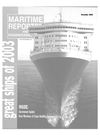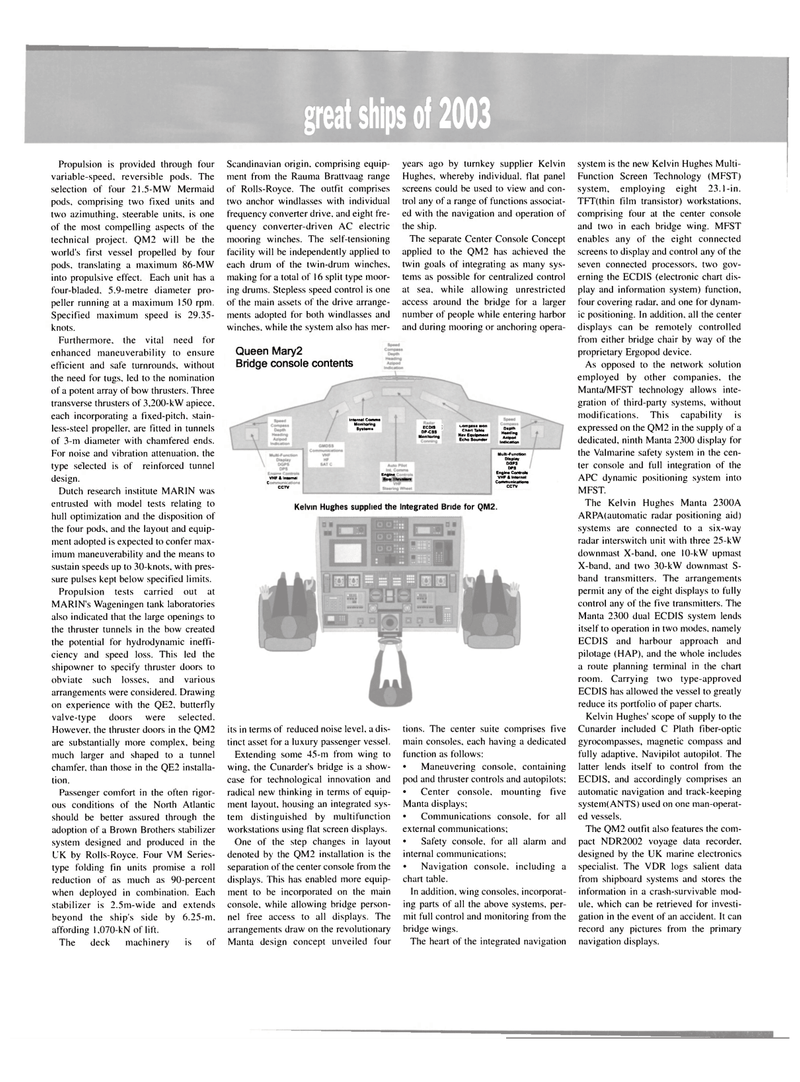
Page 30: of Maritime Reporter Magazine (December 2003)
Grear Ships of 20003
Read this page in Pdf, Flash or Html5 edition of December 2003 Maritime Reporter Magazine
great ships of 2003
Propulsion is provided through four variable-speed, reversible pods. The selection of four 21.5-MW Mermaid pods, comprising two fixed units and two azimuthing, steerable units, is one of the most compelling aspects of the technical project. QM2 will be the world's first vessel propelled by four pods, translating a maximum 86-MW into propulsive effect. Each unit has a four-bladed, 5.9-metre diameter pro- peller running at a maximum 150 rpm.
Specified maximum speed is 29.35- knots.
Furthermore, the vital need for enhanced maneuverability to ensure efficient and safe turnrounds, without the need for tugs, led to the nomination of a potent array of bow thrusters. Three transverse thrusters of 3,200-kW apiece, each incorporating a fixed-pitch, stain- less-steel propeller, are fitted in tunnels of 3-m diameter with chamfered ends.
For noise and vibration attenuation, the type selected is of reinforced tunnel design.
Dutch research institute MARIN was entrusted with model tests relating to hull optimization and the disposition of the four pods, and the layout and equip- ment adopted is expected to confer max- imum maneuverability and the means to sustain speeds up to 30-knots, with pres- sure pulses kept below specified limits.
Propulsion tests carried out at
MARIN's Wageningen tank laboratories also indicated that the large openings to the thruster tunnels in the bow created the potential for hydrodynamic ineffi- ciency and speed loss. This led the shipowner to specify thruster doors to obviate such losses, and various arrangements were considered. Drawing on experience with the QE2. butterfly valve-type doors were selected.
However, the thruster doors in the QM2 are substantially more complex, being much larger and shaped to a tunnel chamfer, than those in the QE2 installa- tion.
Passenger comfort in the often rigor- ous conditions of the North Atlantic should be better assured through the adoption of a Brown Brothers stabilizer system designed and produced in the
UK by Rolls-Royce. Four VM Series- type folding fin units promise a roll reduction of as much as 90-percent when deployed in combination. Each stabilizer is 2.5m-wide and extends beyond the ship's side by 6.25-m, affording 1,070-kN of lift.
The deck machinery is of
Scandinavian origin, comprising equip- ment from the Rauma Brattvaag range of Rolls-Royce. The outfit comprises two anchor windlasses with individual frequency converter drive, and eight fre- quency converter-driven AC electric mooring winches. The self-tensioning facility will be independently applied to each drum of the twin-drum winches, making for a total of 16 split type moor- ing drums. Stepless speed control is one of the main assets of the drive arrange- ments adopted for both windlasses and winches, while the system also has mer- its in terms of reduced noise level, a dis- tinct asset for a luxury passenger vessel.
Extending some 45-m from wing to wing, the Cunarder's bridge is a show- case for technological innovation and radical new thinking in terms of equip- ment layout, housing an integrated sys- tem distinguished by multifunction workstations using flat screen displays.
One of the step changes in layout denoted by the QM2 installation is the separation of the center console from the displays. This has enabled more equip- ment to be incorporated on the main console, while allowing bridge person- nel free access to all displays. The arrangements draw on the revolutionary
Manta design concept unveiled four years ago by turnkey supplier Kelvin
Hughes, whereby individual, flat panel screens could be used to view and con- trol any of a range of functions associat- ed with the navigation and operation of the ship.
The separate Center Console Concept applied to the QM2 has achieved the twin goals of integrating as many sys- tems as possible for centralized control at sea, while allowing unrestricted access around the bridge for a larger number of people while entering harbor and during mooring or anchoring opera- tions. The center suite comprises five main consoles, each having a dedicated function as follows: • Maneuvering console, containing pod and thruster controls and autopilots; • Center console, mounting five
Manta displays; • Communications console, for all external communications; • Safety console, for all alarm and internal communications; • Navigation console, including a chart table.
In addition, wing consoles, incorporat- ing parts of all the above systems, per- mit full control and monitoring from the bridge wings.
The heart of the integrated navigation system is the new Kelvin Hughes Multi-
Function Screen Technology (MFST) system, employing eight 23.1-in.
TFT(thin film transistor) workstations, comprising four at the center console and two in each bridge wing. MFST enables any of the eight connected screens to display and control any of the seven connected processors, two gov- erning the ECDIS (electronic chart dis- play and information system) function, four covering radar, and one for dynam- ic positioning. In addition, all the center displays can be remotely controlled from either bridge chair by way of the proprietary Ergopod device.
As opposed to the network solution employed by other companies, the
Manta/MFST technology allows inte- gration of third-party systems, without modifications. This capability is expressed on the QM2 in the supply of a dedicated, ninth Manta 2300 display for the Valmarine safety system in the cen- ter console and full integration of the
APC dynamic positioning system into
MFST.
The Kelvin Hughes Manta 2300A
ARPA(automatic radar positioning aid) systems are connected to a six-way radar interswitch unit with three 25-kW downmast X-band, one 10-kW upmast
X-band. and two 30-kW downmast S- band transmitters. The arrangements permit any of the eight displays to fully control any of the five transmitters. The
Manta 2300 dual ECDIS system lends itself to operation in two modes, namely
ECDIS and harbour approach and pilotage (HAP), and the whole includes a route planning terminal in the chart room. Carrying two type-approved
ECDIS has allowed the vessel to greatly reduce its portfolio of paper charts.
Kelvin Hughes' scope of supply to the
Cunarder included C Plath fiber-optic gyrocompasses, magnetic compass and fully adaptive, Navipilot autopilot. The latter lends itself to control from the
ECDIS, and accordingly comprises an automatic navigation and track-keeping system( ANTS) used on one man-operat- ed vessels.
The QM2 outfit also features the com- pact NDR2002 voyage data recorder, designed by the UK marine electronics specialist. The VDR logs salient data from shipboard systems and stores the information in a crash-survivable mod- ule, which can be retrieved for investi- gation in the event of an accident. It can record any pictures from the primary navigation displays.
Kelvin Hughes supplied the Integrated Bride for QM2.
Queen Mary2
Bridge console contents
VHF & Internal
Communications
CCTV
Multi -Function
Display
DOP3
DPS
Engine Controls
VHF & Internal
Communications
CCTV ecdis ;
DP-CSS
Monitoring
Depth
Heading
Azipod
Indication
Internal Comms
Monitoring
Systems
Engine
Bow Thrusters compass won
Chart Table
Nav Equipment
Echo Sounder

 29
29

 31
31
